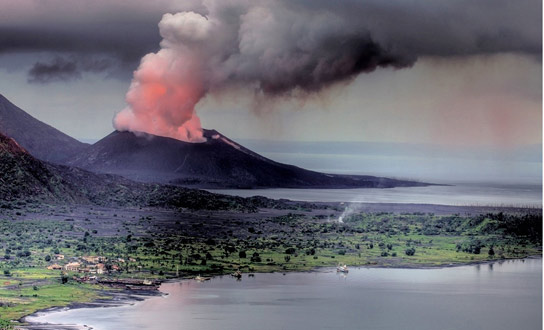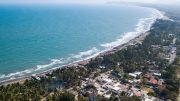
This image was taken during the August 2014 eruption of Tavurvur in Papua New Guinea. Credit: Lawrence Livermore National Laboratory
Researchers from the Lawrence Livermore National Laboratory show that the “warming hiatus” that has occurred over the last 15 years has been caused in part by small volcanic eruptions.
Scientists have long known that volcanoes cool the atmosphere because of the sulfur dioxide that is expelled during eruptions. Droplets of sulfuric acid that form when the gas combines with oxygen in the upper atmosphere can persist for many months, reflecting sunlight away from Earth and lowering temperatures at the surface and in the lower atmosphere.
Previous research suggested that early 21st-century eruptions might explain up to a third of the recent warming hiatus.
New research available online in the journal Geophysical Research Letters (GRL) further identifies observational climate signals caused by recent volcanic activity. This new research complements an earlier GRL paper published in November, which relied on a combination of ground, air, and satellite measurements, indicating that a series of small 21st-century volcanic eruptions deflected substantially more solar radiation than previously estimated.
“This new work shows that the climate signals of late 20th- and early 21st-century volcanic activity can be detected in a variety of different observational data sets,” said Benjamin Santer, a Lawrence Livermore National Laboratory scientist and lead author of the study.
The warmest year on record is 1998. After that, the steep climb in global surface temperatures observed over the 20th century appeared to level off. This “hiatus” received considerable attention, despite the fact that the full observational surface temperature record shows many instances of slowing and acceleration in warming rates. Scientists had previously suggested that factors such as weak solar activity and increased heat uptake by the oceans could be responsible for the recent lull in temperature increases. After the publication of a 2011 paper in the journal Science by Susan Solomon of the Massachusetts Institute of Technology (MIT), it was recognized that an uptick in volcanic activity might also be implicated in the warming hiatus.
Prior to the 2011 Science paper, the prevailing scientific thinking was that only very large eruptions — on the scale of the cataclysmic 1991 Mount Pinatubo eruption in the Philippines, which ejected an estimated 20 million metric tons (44 billion pounds) of sulfur — were capable of impacting global climate. This conventional wisdom was largely based on climate model simulations. But according to David Ridley, an atmospheric scientist at MIT and lead author of the November GRL paper, these simulations were missing an important component of volcanic activity.
Ridley and colleagues found the missing piece of the puzzle at the intersection of two atmospheric layers, the stratosphere and the troposphere — the lowest layer of the atmosphere, where all weather takes place. Those layers meet between 10 and 15 kilometers (six to nine miles) above the Earth.
Satellite measurements of the sulfuric acid droplets and aerosols produced by erupting volcanoes are generally restricted to above 15 km (9 mi). Below 15 km, cirrus clouds can interfere with satellite aerosol measurements. This means that toward the poles, where the lower stratosphere can reach down to 10 km (6 mi), the satellite measurements miss a significant chunk of the total volcanic aerosol loading.
To get around this problem, the study by Ridley and colleagues combined observations from ground-, air- and space-based instruments to better observe aerosols in the lower portion of the stratosphere. They used these improved estimates of total volcanic aerosols in a simple climate model, and estimated that volcanoes may have caused cooling of 0.05 degrees to 0.12 degrees Celsius (0.075 degrees to 0.22 degrees Fahrenheit) since 2000.
The second Livermore-led study shows that the signals of these late 20th and early 21st eruptions can be positively identified in atmospheric temperature, moisture, and the reflected solar radiation at the top of the atmosphere. A vital step in detecting these volcanic signals is the removal of the “climate noise” caused by El Niños and La Niñas.
“The fact that these volcanic signatures are apparent in multiple independently measured climate variables really supports the idea that they are influencing climate in spite of their moderate size,” said Mark Zelinka, another Livermore author. “If we wish to accurately simulate recent climate change in models, we cannot neglect the ability of these smaller eruptions to reflect sunlight away from Earth.”
References:
“Observed multi-variable signals of late 20th and early 21st century volcanic activity” by Benjamin D. Santer, Susan Solomon, Céline Bonfils, Mark D. Zelinka, Jeffrey F. Painter, Francisco Beltran, John C. Fyfe, Gardar Johannesson, Carl Mears, David A. Ridley, Jean-Paul Vernier and Frank J. Wentz, 29 December 2014, Geophysical Research Letters.
DOI: 10.1002/2014GL062366
“Total volcanic stratospheric aerosol optical depths and implications for global climate change” by D. A. Ridley, S. Solomon, J. E. Barnes, V. D. Burlakov, T. Deshler, S. I. Dolgii, A. B. Herber, T. Nagai, R. R. Neely III, A. V. Nevzorov, C. Ritter, T. Sakai, B. D. Santer, M. Sato, A. Schmidt, O. Uchino and J. P. Vernier, 31 October 2014, Geophysical Research Letters.
DOI: 10.1002/2014GL061541









So there were no (small or large) volcanic eruptions between 1900 and 1995? If it was these eruptions (from 1995 to today) that have caused the “pause” in global warming than there could not have been any eruptions between the earlier years (don’t bet the milk money on that one).
Once again, so-called “scientists” trying to grasp anything they can to keep the Global Climate Change money coming in and to “heck” with the facts.
Please tell me you aren’t this stupid. Your lack of logic on this subject is astounding.
You need to stop watching Fox News, and start visiting actual science websites you know.. with things like “facts”?
Lets try to dumb this down for you.
The trend for temperatures has been going in an upward fashion for decades. While the trend is going up, that doesn’t mean certain periods of time it is not cooler. All it means is right now, it is remaining level but will go back up when the volcanic eruptions have slowed.
Seriously, don’t talk science like you know what you are talking about. Fox News has no grasp of science, and therefore, neither do you.
What a royal douchebag… So, because someone is skeptical of a highly likely fraud, such as GW, then they are OBVIOUSLY Fox News watchers? Get your head out of your partisan @ss and look at the big picture. There are lots of pretty big holes in the GW theory, yet, as an avowed liberal, you seem to be incapable of seeing how ridiculous you sound. You seem to think that you “know science”, while anyone that disagrees is just ignorant… That’s not how science works, @sshat. That’s how politics works.
Did you take your Hydroxychloroquine today?
Well, hey, all we have to do is get those volcanoes under control and we can solve global climate change. Piece o’cake.